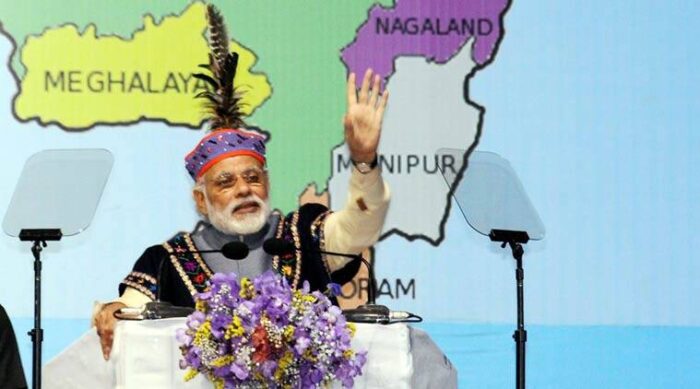
File Picture
It will not surprise a discerning observer of the north east as to why there is little enthusiasm in the region to observe the 50 th anniversary of the NEA Reorganization Act on 31 Dec of this year, even though it was the first major reform after independence to shape political identities of Hill tribes by departing from the usual criteria for grant of” statehood” such as financial viability. This is because of a perception – widely prevalent in the region that the ” reorganization is an unfinished task”
Several facts are cited in support of this view : First, continuing violent movements for separate statehood in the Sixth schedule areas of Karbi Anglong, Dima Hasao ‘ and Bodoland in Assam :Second, similar demands in Hill areas of Manipur and growing unrest in Tribal areas of Tripura and consequently a major part of the north east including the whole of Assam continue to be ” disturbed areas”.
Even then the North Eastern Areas Reorganization Act was a game changer as it recognised the strategic importance of the “North East areas”, that is, “area East of Siliguri ” just as the British viewed it as the ” Eastern frontier” of Bengal Presidency under the Bengal Eastern Frontier Regulation Act 1873. Separation of Naga Hills and Tuensang Areas from Assam and creation of Nagaland under the State of Nagaland Act 1962 was the first step to reorganize the composite state of Assam.
The 1971 NEA Reorganization Act was preceded by Assam Reorganization (Meghalaya)Act 1969 to establish Meghalaya , an” autonomous state” within Assam in Hill areas and before it could settle down the liberation struggle in East Pakistan created the need for strengthening the administration of the region bordering East Pakistan. Thus the grant of full statehood to the Autonomous state of Meghalaya, UTs of Tripura and Manipur and UT status to NEFA , separation of Mizo district from Assam as an UT under the NEA Reorganization Act 1971 changed the political and administrative setup of the north east as never before.
Further, the establishment of the North Eastern Council under the NEC Act enacted by the Parliament in the same year-1971 as ” a Regional planning body” put in place for the first time in the North East a common development platform and an agenda as the constituent units of the north east didn’t really add up to an economy ,and thus needed integration into the larger eastern Indian and economies in its neighborhood such as Bangladesh and Myanmar. No doubt it was a historic initiative. However things didn’t work out as expected because of continuing insurgency in Mizoram , tribal unrest in Tripura and the outbreak of widespread ethnic violence across the region from 1979-80 on the ” foreign nationals” issue which took the state and central authorities by surprise and destabilized the NE. Assam , the worst affected state experienced ” no real growth” for the two decades – 1980’s. and 1990’s as noted in the Approach to the 12 th Plan document of the Planning Commission.
This however didn’t hinder further restructuring of the states as extension of the Sixth schedule to Tripura Tribal areas District in 1984 by the 49 th Amendment to the Constitution was followed by grant of full statehood to Mizoram in 1986 after signing of the Accord with the Mizo National Front on June 30 ,1986 ending 20 years of Mizo insurgency. It may be recalled that under a State legislation enacted in 1979 Autonomous District councils were already functioning in Tribal areas of Tripura just as District councils were functioning since 1971 in Hill areas of Manipur under a state law.
From this it is clear that 1971 Reorganization was in a way the beginning of a seemingly unending process administrative reconstruction of NE States ostensibly to meet the aspirations of distinct groups. Analysing these developments in the region one gets the feeling that identity assertion has been incentivised under the state policy without any significant economic or social growth. There are at present 9 Autonomous councils in Assam including 3 established under the state laws enacted in September 2020 for Moran , Motok and Koch Rajbanshis who are presently in the OBC group but under active consideration for inclusion in the list of Scheduled Tribes while the remaining six councils set up earlier covered Scheduled Tribes Plains . The three districts under the Sixth schedule are Karbi Anglong and Dima Hasao which were notified under the sixth schedule as originally enacted in the constitution while Bodoland Territorial Administrative District was put under the same only after the 2003 Bodo Accord . In Assam there are also 33 Development Councils for ” Backward Communities” which include interestingly Assamese Brahmins and Kalitas , Manipuris , Gorkhas and even Bengali and Hindi speaking people which make little administrative sense. It is high time to carry out a proper evaluation of these councils to know why their activities made no difference in the performance of Assam in attaining the Sustainable development goals ( SDG ) as Assam has been ranked at the very bottom of the list of states – only above Bihar in this year’s assessment by the NTI Aayog. As if these were not enough, a few days back the Department of welfare of Plains Tribes and Back ward classes, Assam have asked all DC’s to report on 33 communities which include the communities mentioned above .
The emphasis on the ” indigenous” in the development discourse all over the north east misses the point that the concept of indigeneity doesn’t exist in the constitution. This, argued Dr. Hiren Gohain, distinguished public intellectual in a recent Dainik Asom article would be a kind of ” separate development” which is not envisaged in the constitution and prima facie not in tune with the Prime minister Modi’s call ” Sabka Sath Sabka Vikas” which captures the spirit of the Indian democracy .
In this situation the proposal to add Six groups in Assam – presently in the OBC list to the list of Scheduled Tribes would further expand the base of demand for” separate development”, and given the resource crunch it would be hard to implement. It might give rise to What Pankaj Mishra called ” ressentiment” in his “Age of Anger”, that is ,a feeling of deep anger in the minds of ” others” kept out of the scheme.
The “Autonomous councils” set up in the North East states after reorganization of 1971 including 9 under the Sixth schedule and Development Councils in Assam would add up to about 50 and might be seen as continuation of reorganization of the Region by other means. This has produced an unviable political power structure with multiple power centres which have rendered development initiatives of the NEC and the Department for Development of the NER less effective. And given the fact of China’s long involvement in aiding and abetting ” insurgencies” in the North East this kind of social engineering policy will only divide the political Society as Aristotle viewed it and promote inefficient use of scarce resources which is only to the advantage of our adversaries.
What North East needs a regional administrative platform, if not a government to address the common issues of development and especially growth of infrastructure and security. Though this was implicit in the NEC, spread and deepening of identity politics obstructed growth of appropriate institutions of regional development and thereby slowed down implementation of major initiatives such as the Act East policy. It is time now to look back to change the course towards a cohesive north east and not one broken into, in the words of Tagore ” narrow domestic walls”.
[the_ad id=”41099″]


















